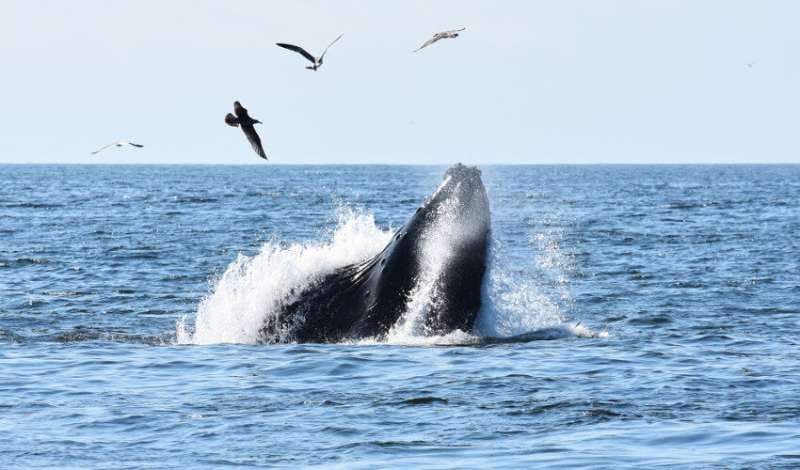
If you lived on the West Coast anytime in the past several years, you may remember news of "the Blob"—not a horror movie monster but a mass of warm water that resulted from a marine heat wave in 2014 and 2015. A new publication led by a San Francisco State University alumna shows how that ocean anomaly brought whales and Dungeness crab fishers on a collision course—the newest in a line of research from the lab of Professor of Geography & Environment Ellen Hines showing the complicated and not always successful ways humans try to share space with marine life.
Ever since the emergence of the blob, an increasing number of whales and dolphins have been seen close to shore and within San Francisco Bay. While these sightings are exciting for the everyday tourist biking over the Golden Gate Bridge or whale watching on the water, not everyone is thrilled. As whales began moving closer to shore looking for food, more began getting caught and entangled in fishing gear. This was worrisome for both the Dungeness crab fishing community and marine mammal researchers.
"[Fishers] care about the environment; the environment needs to be conducive to producing the product that they're trying to fish, so they do care a lot," said Kaytlin Ingman, an SF State alumna and lead author of the paper.
Ingman's research, which she conducted as a student at the SF State Estuary and Ocean Science Center and recently published in the journal PLOS One, investigated the timing of blue, gray and humpback whales throughout the Farallon Islands area in California. When water temperature increased, Ingman found that whales arrived earlier off the coast of San Francisco—putting them at a higher risk of entanglement due to the many fishers on the water during crab season. Scientists anticipate these interactions will continue as warm water events are expected to become more common due to climate change.
Entanglement isn't the only danger whales face within the highly urbanized San Francisco Bay area. Research published in Frontiers in Marine Science by Samantha Cope, another former graduate student in the Hines lab, examined the impact of boats themselves—even the ferries that bring commuters across the Bay daily.
Cope measured vessel traffic throughout San Francisco Bay to understand where boats may pose a collision threat to whales and dolphins. Large vessels were frequently traveling faster than 10 knots, she found, a speed that can lead to whale or dolphin deaths.
Cope's research found that ferries often traveled at speeds greater than 30 knots, equivalent to about 35 mph, and traveled the greatest distance compared to any other vessels found throughout San Francisco Bay. And since ferries are active throughout the day and run almost every single day of the year, that means more opportunities for collisions. Faster boats are also disruptive to marine mammals because of the amount of noise they make—a factor Cope explored in another paper published in the Journal of the Acoustical Society of America.
The lab's focus extends far beyond the Bay: Another study, by alum Nathan Greig from the Geography and Environment department, also published in Frontiers in Marine Science, examined the same phenomenon off the coast of Washington, an area where lethal vessel collisions are common.
Ingman hopes that research that comes out of the Hines lab can lead to more flexible management of ocean resources. "A management that moves depending on where the marine mammals are, or depending on the season, can help both the industry and conservation side," Ingman said. "That way, it can maintain the balance between all parties."
Explore further
Samantha Cope et al. Multi-sensor integration for an assessment of underwater radiated noise from common vessels in San Francisco Bay, The Journal of the Acoustical Society of America (2021). DOI: 10.1121/10.0003963
Citation: Study: Warm water 'blob' put whales on collision course with crab-fishing lines (2021, May 18) retrieved 18 May 2021 from https://ift.tt/3oosHHQ
This document is subject to copyright. Apart from any fair dealing for the purpose of private study or research, no part may be reproduced without the written permission. The content is provided for information purposes only.
May 18, 2021 at 06:00PM
https://ift.tt/3oosHHQ
Study: Warm water 'blob' put whales on collision course with crab-fishing lines - Phys.org
https://ift.tt/2MkGRbk
Crab

No comments:
Post a Comment